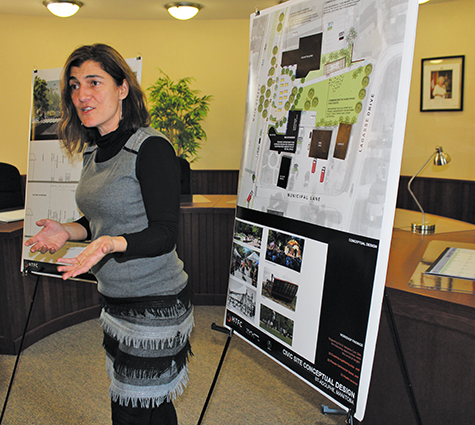
In March, Community Economic Development Officer Lesley Gaudry facilitated Main Street revitalization open houses in Île-des-Chênes, St. Adolphe, and Ste. Agathe, inviting residents to participate by previewing concept plans that have been drawn up for each community.
“We had a great cross-section of folks who came out and provided some valuable feedback on the drawings,” says Gaudry. “We talked about possibilities. We talked about needs. We recognize that these plans are not going to be the be-all and end-all. After these plans are done, the real work, the hard work, begins.”
Gaudry received the green light from Ritchot’s council to begin work on this initiative last year after she’d researched the benefits that other communities have received from community sustainability plans.
“[Ritchot] residents have seen growth in their communities and they have seen their infrastructure age,” adds Gaudry. “What more opportune time to have a proper look at what makes a main street healthy, happy, vibrant, safe, and accessible for meeting places and economic centres? At the same time, this has given us an avenue to connect with our local businesses and say, ‘Thank you for having your business here. We appreciate you.’”
HTFC Planning and Design of Winnipeg was hired to begin work on the projects. The company boasts a 50-year history of outstanding revitalization projects and working with public sector, private sector, and non-profit organizations in communities across Manitoba, Ontario, and northern Canada.
“There are many professions that can look at aspects of revitalization from a specific lens: engineers… social scientists… developers,” says Constantina Douvris, landscape architect for HTFC. “These are all valuable services. However, taken in isolation, they remain disjointed and disconnected parts of a bigger puzzle, driving communities towards disjointed growth and false starts. At HTFC, we look at planning and design problems in a holistic way, considering all of a project’s drivers in developing well-rounded and custom-tailored solutions for each community. HTFC does two things exceptionally well: we fully engage local residents in the design process and we convert ideas into compelling and easy-to-understand visuals that help communities reach consensus as they plan for the future.”
Gaudry says that Ritchot’s revitalization plans include basics such as new signage, crosswalks, curb bumpouts, streetscaping, improved accessibility to sidewalks, and repairs to curbs, gutters, and potholes. Each community, though, is looking beyond basic renewal to include fea-tures such as roundabouts for better main street access, community greenspaces that will double as areas for outdoor markets, and plenty of trees, shrubs, and flower gardens.
Because of the high volume of recreational cyclist traffic from Winnipeg, St. Adolphe’s proposal includes bike lanes to make their community safer and more welcoming.
Joanne Lagasse, a 50-year resident of St. Adolphe, says that speeding along Main Street is one of her biggest concerns. While adding parking bubbles might slow traffic down, she wonders if adding these bumpouts and bike lanes to the outside lanes might create bottlenecks for the heavy traffic travelling through on a daily basis.
“My concern would be the traffic [numbers] still won’t be reduced and how many [speed limit] signs are they willing to put up?” says Lagasse.
According to Lagasse, there are currently no speed limit signs along Main Street and accidents are a common occurrence at the south end of town. She sees some favourable aspects to the proposed revitalization plan, though.
“I kind of like the idea of a park-like setting [on Main Street],” adds Lagasse. “I love the idea of [adding] trees. It beautifies everything, and lighting would be a big thing. We don’t have enough [street] lighting.”
The proposed plans for Île-des-Chênes and Ste. Agathe include walking and bike corridors to connect schools and new developments to the downtown areas, as well as Main Street design elements that engage their heritage and francophone cultures.
As for the timing of the projects, Gaudry says there are still a lot of details to be worked out, and much will depend upon what each community places at the top of their priorities list.
“You could see changes as early as this fall and next spring,” says Gaudry. “Changes need to be a partnership decision between economic development, council, public works, residents, and businesses. Some things the RM controls… and other items will [require dialogue] with Manitoba Infrastructure and Transportation for years to come. But at least we have a plan, a well thought-out, solid plan to start the conversations.”
Douvris says that these initial stages of planning and community involvement are integral to creating a personalized approach to each community rather than a cookie-cutter solution. Each Ritchot community will see very different Main Street results, reflecting their unique character, locations, and goals.
“Main streets are the heart of a community,” says Douvris. “A vibrant and accessible main street that welcomes all residents…builds a core that supports local business and economic development while promoting social interaction, alternate modes of transportation, community connectivity, overall wellness, and community pride. When done right, main streets are social hubs that reflect the heritage, culture, and character of a settlement. Building better main streets makes economic sense [by] supporting local entrepreneurs, encouraging local and regional tourism, and attracting investment.”



















